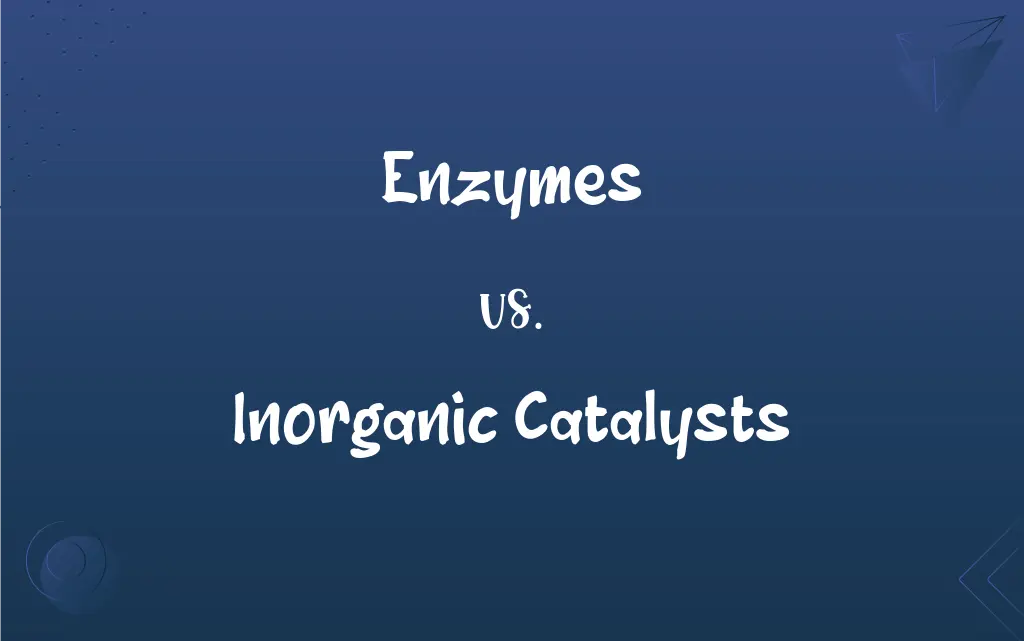Enzymes vs. Inorganic Catalysts: What's the Difference?
Edited by Aimie Carlson || By Harlon Moss || Updated on October 14, 2023
Enzymes are biological catalysts accelerating chemical reactions in organisms. Inorganic Catalysts are non-biological substances that speed up reactions without undergoing permanent changes.

Key Differences
Enzymes, heralded for their specificity, uniquely serve as catalysts, remarkably selective in nature and tailored to facilitate precise biological reactions. Inorganic catalysts, on the other hand, lack this rigorous specificity, often catalyzing a broader spectrum of reactions. They perform their function in numerous contexts, including industrial processes, where specificity may not be paramount. The specificity of enzymes arises from their intricate three-dimensional structures, enabling a precise fit for substrate molecules.
Inorganic catalysts are notably robust, typically withstanding harsh conditions such as high temperatures and extreme pH levels. Unlike enzymes, their stability and tolerance to various physical conditions make them advantageous in industrial applications, where aggressive conditions are often employed to expedite chemical processes. Enzymes, contrarily, possess a delicate nature, with their functionality becoming compromised under extreme conditions, particularly at elevated temperatures or away from their optimal pH, thus constraining their utility in certain industrial applications.
Considering their sources, enzymes are inherently derived from biological organisms, contributing significantly to metabolic processes and other vital biochemical reactions. In contrast, inorganic catalysts have no biological origin, and are formulated from materials that are not part of living organisms. These catalysts are frequently utilized in the chemical industry to catalyze reactions like hydrogenation and polymerization, and their efficacy is not predominantly governed by the complexities of biological systems, unlike enzymes.
The application of enzymes typically aligns with a sustainable and environmentally conscious approach due to their biodegradable nature and operation under mild conditions. Inorganic catalysts might require high energy inputs and may give rise to disposal concerns due to their non-biodegradable nature. Enzymes tend to manifest as inherently eco-friendly, working efficiently at moderate temperatures and reducing energy consumption, while some inorganic catalysts may necessitate careful management to mitigate environmental impact.
Enzyme activity is modulated through various cellular mechanisms, ensuring their catalytic actions synchronize well with the physiological demands of the organism. Inorganic catalysts, devoid of such intricate regulatory mechanisms, operate independently of biological regulatory systems. The capability of cells to manage enzyme activity through feedback mechanisms and allosteric modulation underscores a level of control that is unattainable with inorganic catalysts in biological contexts.
ADVERTISEMENT
Comparison Chart
Origin
Biological organisms
Non-biological materials
Specificity
Highly specific
Broad spectrum
Stability
Sensitive to extreme conditions
Robust under harsh conditions
Environmental Impact
Generally eco-friendly
Can have significant environmental impact
Regulation of Activity
Subject to cellular regulatory mechanisms
Not regulated in biological systems
ADVERTISEMENT
Enzymes and Inorganic Catalysts Definitions
Enzymes
The structure of enzymes allows them to bind specifically to other molecules, called substrates.
The enzyme lactase binds to lactose to break it down into simpler sugars, aiding digestion.
Inorganic Catalysts
Some inorganic catalysts, by virtue of their stability and reusability, find applications in processes where enzymes might be unstable.
Inorganic catalysts are used in the cracking of hydrocarbons in the petroleum industry, where high temperatures would denature enzymes.
Enzymes
Enzymes are biological catalysts that accelerate chemical reactions in living organisms.
Enzymes in our saliva kickstart the process of breaking down food into simpler molecules.
Inorganic Catalysts
Inorganic catalysts are substances, not derived from living organisms, that accelerate chemical reactions without being consumed.
Platinum, an inorganic catalyst, is widely used in catalytic converters to reduce harmful emissions from vehicles.
Enzymes
Enzymes operate under mild conditions, with optimal activity at specific temperatures and pH levels.
Enzymes in the human body often exhibit peak activity at body temperature (approximately 37°C).
Inorganic Catalysts
Unlike enzymes, inorganic catalysts are not regulated by cellular mechanisms and don't bind to substrates in a highly specific manner.
Inorganic catalysts like iron aren’t subject to biological control and catalyze a multitude of different reactions in industrial settings.
Enzymes
Enzymes are susceptible to denaturation, losing their functionality when exposed to harsh conditions.
Cooking food denatures its enzymes, inhibiting their ability to catalyze reactions.
Inorganic Catalysts
These catalysts can endure harsh conditions, like high temperatures and extreme pH levels, without losing their efficacy.
Inorganic catalysts are integral in industrial processes, like the Haber process, where they function under extreme conditions to synthesize ammonia.
Enzymes
Enzymes can be inhibited or activated by specific molecules, modulating their activity.
Some drugs act by inhibiting specific enzymes, thereby altering cellular metabolic pathways.
Inorganic Catalysts
Inorganic catalysts facilitate a wide array of chemical reactions, often lacking the specificity characteristic of enzymes.
Nickel, an inorganic catalyst, is used in hydrogenation reactions, converting alkenes into alkanes in the presence of hydrogen.
Enzymes
Any of numerous compounds that are produced by living organisms and function as biochemical catalysts. Some enzymes are simple proteins, and others consist of a protein linked to one or more nonprotein groups.
Enzymes
Plural of enzyme
FAQs
What characterizes inorganic catalysts?
Inorganic catalysts are non-biological substances that accelerate chemical reactions without being consumed or altered permanently.
What are enzymes?
Enzymes are biological catalysts that speed up chemical reactions in living organisms.
Can inorganic catalysts function in harsh conditions?
Yes, inorganic catalysts can function under harsh conditions like extreme temperatures and pH levels.
Can enzymes be regulated within biological systems?
Yes, enzymes are subject to cellular regulation mechanisms to control their activity and prevent unwarranted reactions.
Can inorganic catalysts catalyze multiple types of reactions?
Yes, inorganic catalysts often catalyze a wide range of reactions and lack the specificity that enzymes exhibit.
Are inorganic catalysts affected by cellular regulatory mechanisms?
No, inorganic catalysts operate independently of cellular regulatory mechanisms, as they are not part of biological systems.
How do enzymes exhibit specificity?
Enzymes exhibit specificity by having unique active sites that bind precisely to specific substrate molecules.
How do enzymes facilitate biochemical reactions?
Enzymes lower the activation energy of biochemical reactions, enabling them to proceed more rapidly.
Are enzymes used in industrial processes?
Yes, enzymes are used in some industrial processes, especially those requiring specificity and operating under mild conditions.
Can enzymes and inorganic catalysts be inhibited?
Yes, both can be inhibited, but the mechanisms and substances used for inhibition typically differ between them.
Are inorganic catalysts biodegradable?
No, inorganic catalysts are not biodegradable and require specific disposal or recycling procedures.
Can enzymes be used in washing detergents?
Yes, enzymes are used in detergents to break down stains, such as proteins or fats, at lower temperatures.
What is an example of an inorganic catalyst used in pollution control?
Platinum, used in catalytic converters to reduce vehicle emissions, is an example of an inorganic catalyst applied in pollution control.
How do cells prevent unwanted enzyme activity?
Cells inhibit unwanted enzyme activity using various mechanisms, like allosteric inhibition or by producing inhibitor molecules.
How do enzymes and inorganic catalysts interact with substrates?
Enzymes interact with substrates via specific active sites, whereas inorganic catalysts do not have such specificity and may interact with a variety of molecules.
Are enzymes sensitive to environmental conditions?
Yes, enzymes are sensitive to conditions like temperature and pH, and can lose functionality if these are not optimal.
Are inorganic catalysts used in industrial applications?
Yes, inorganic catalysts are widely used in various industrial processes due to their stability and broad reactivity.
What makes inorganic catalysts suitable for industrial use?
Inorganic catalysts are robust, stable under harsh conditions, and can facilitate a wide range of reactions, making them suitable for industrial use.
What is the primary structural difference between enzymes and inorganic catalysts?
Enzymes are large, complex proteins with specific active sites, while inorganic catalysts are generally simple, solid substances without specific binding sites.
Can enzymes operate effectively in high-temperature industrial processes?
Generally, no—enzymes tend to denature at high temperatures, losing their functional conformation and activity.
About Author
Written by
Harlon MossHarlon is a seasoned quality moderator and accomplished content writer for Difference Wiki. An alumnus of the prestigious University of California, he earned his degree in Computer Science. Leveraging his academic background, Harlon brings a meticulous and informed perspective to his work, ensuring content accuracy and excellence.
Edited by
Aimie CarlsonAimie Carlson, holding a master's degree in English literature, is a fervent English language enthusiast. She lends her writing talents to Difference Wiki, a prominent website that specializes in comparisons, offering readers insightful analyses that both captivate and inform.































































